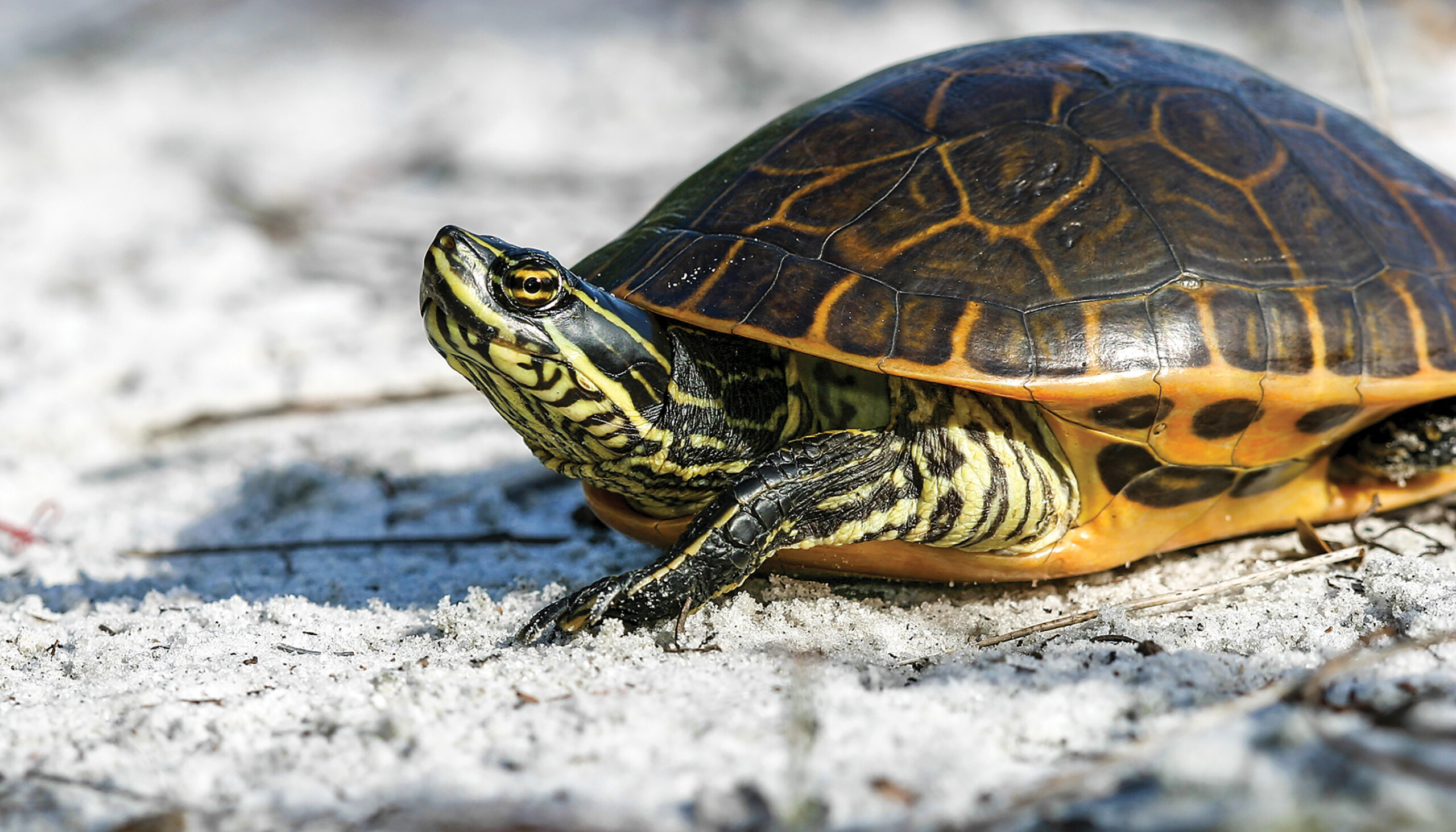Turtles, these ancient and enigmatic creatures, have always captivated our imagination with their slow yet graceful movement. Their unique anatomy and life history tell a story as old as time itself, making them not just survivors but living symbols of resilience. In this article, we’ll delve into the world of turtles, exploring their habitats, behaviors, relationships with humans, and the conservation efforts aimed at protecting these remarkable beings.
The Anatomy of Turtle Movement
Understanding how turtles move begins with an appreciation of their anatomical structure. They are designed for both aquatic and terrestrial environments, and their unique features enable them to navigate through diverse terrains.
>>> Buy now: Turtle Art 02 Bedding Sets Duvet Cover Bedroom Quilt Bed
Shell Structure and Function
The turtle’s shell is one of its most distinctive features. Comprising two parts—the carapace (the top) and the plastron (the underside)—the shell protects vital organs from predators and environmental hazards.
The shell is made up of bony plates covered with scutes, which are keratinous scales that prevent water loss and provide additional protection. This remarkable design allows turtles to retreat into their shells for safety, demonstrating an evolutionary advantage in a world filled with threats.
Moreover, the shape and size of a turtle’s shell often correlate with its habitat. Aquatic turtles tend to have more streamlined shapes, enabling them to glide through the water with minimal resistance, while land turtles possess domed shells that provide stability on uneven terrain. This adaptation showcases the elegance of nature’s design and the significance of form following function.
Limb Adaptations
A turtle’s limbs also play a crucial role in its movement. While all turtles possess four limbs, their anatomy varies depending on their lifestyle. Aquatic species have flippers that allow them to swim efficiently, while terrestrial species have sturdy legs adapted for walking and burrowing.
Flippers are flattened, enabling turtles like the sea turtle to propel themselves powerfully through the water. These adaptations not only enhance their swimming ability but also contribute to their energy efficiency, allowing them to cover great distances during migrations.
In contrast, land turtles, such as tortoises, have more robust legs that support their weight and assist in climbing over rocks and navigating through vegetation. This diversity in limb structure reflects the adaptive strategies that turtles have developed to thrive in various environments.
Muscle Coordination and Movement
The gracefulness of a turtle’s movement can be attributed to its muscle coordination. Despite their seemingly slow pace, turtles exhibit remarkable strength and agility when necessary. Their muscles enable smooth, fluid movements, whether they are swimming gracefully through the ocean or slowly traversing land.
When swimming, turtles use a combination of lateral and vertical movements to navigate. Their powerful front flippers pull them forward while the hind flippers help maintain stability. Engaging in this rhythmic motion allows turtles to conserve energy, making them efficient swimmers capable of covering long distances without becoming fatigued.
On land, the movement of turtles becomes a study in patience and persistence. Their slow and deliberate steps may seem clumsy, but there’s an underlying strength in each movement. Observing a turtle as it makes its way across a patch of grass or sand reveals a sense of purpose and determination that resonates deeply within observers.
The Life Cycle of Turtles
Turtles have a fascinating life cycle that can span decades, and understanding their journey from hatchling to adult is essential to appreciating their existence.
Nesting and Hatching
The nesting process is a critical phase in the life cycle of turtles. Female turtles venture onto land to lay their eggs in sandy nests. This instinctual behavior often occurs at night, possibly to avoid predators and extreme temperatures.
Once the eggs are laid, the mother turtle returns to the sea, leaving the eggs to incubate. The temperature of the sand plays a pivotal role in determining the sex of the hatchlings, showcasing the delicate balance of nature. Warmer sands produce females, while cooler sands yield males, highlighting the intricate relationship between environment and biology.
After several weeks, the hatchlings emerge from their eggs—a moment filled with drama and suspense. As they break free, they instinctively make their way towards the ocean, guided by natural light and the sound of waves. This perilous journey is fraught with danger, as they face numerous predators, including birds and crabs.
The resilience displayed by these tiny creatures is awe-inspiring. The struggle to survive during this critical phase speaks volumes about the natural world’s harsh realities and the need for conservation efforts to protect vulnerable populations.
Growth and Maturity
As they grow, turtles experience significant changes. From hatchlings barely larger than a coin, they develop into recognizable forms, albeit at a slow pace. This gradual growth allows them to adapt to their environments and avoid detection by predators.
Different species of turtles follow varying growth rates; some reach maturity in just a few years, while others take decades to achieve full size. The extended growth period often translates into increased longevity, with some species living well over a century.
During this phase, turtles learn to navigate their surroundings, establish feeding territories, and even engage in social interactions. Observations indicate that certain species may demonstrate social behavior, forming loose groups while foraging or basking in the sun—a lesser-known aspect of turtle life that adds depth to our understanding of these creatures.
Reproduction and Longevity
Reproduction is a significant milestone in a turtle’s life. Once sexually mature, turtles embark on a quest to find mates and continue their lineage. Mating rituals vary among species, with courtship often involving intricate displays and physical interactions.
Following mating, female turtles return to the nesting grounds, driven by an innate urge to lay their eggs in the same areas where they were born. This phenomenon, known as natal homing, underscores the deep connection turtles have with their environment and the cycles of life.
As turtles age, they become more adept at surviving in their habitats. Their hard shells and learned behaviors offer protection against predators and environmental challenges. However, the longevity of turtles faces threats from habitat destruction, climate change, and human activities, making conservation efforts more urgent than ever.
Turtles and Their Ecosystem
The role of turtles in their ecosystems extends beyond their slow movements and serene personalities. They are integral components of the ecological web, contributing to the health and balance of their environments.
Herbivorous and Carnivorous Roles
Depending on the species, turtles can be herbivores, carnivores, or omnivores. For instance, green sea turtles primarily consume seagrass and algae, playing a vital role in maintaining healthy seagrass beds, which provide habitat for countless marine organisms.
Conversely, snapping turtles and some freshwater species feed on fish, amphibians, and even carrion, helping to regulate populations of these animals. By consuming different types of food, turtles contribute to nutrient cycling and energy transfer within their ecosystems.
Their dietary habits also affect their habitats. Grazing by herbivorous turtles prevents overgrowth, allowing a diverse range of plant species to flourish. This promotes biodiversity and creates a balanced ecosystem that supports various other species, reinforcing the interconnectedness of all living things.
Habitat and Shelter Providers
Turtles significantly impact the physical structure of their habitats, particularly in aquatic ecosystems. Their nesting activities help aerate the soil, promoting healthy plant growth and contributing to the overall ecological integrity of their surroundings.
Aquatic turtles often create burrows and hiding spots in riverbanks and pond edges, which provide shelter for various organisms. These actions highlight the ripple effect that turtles have on their environments, emphasizing their importance in maintaining biodiversity.
Additionally, turtle carcasses serve as a food source for scavengers and decomposers, further enriching the ecosystem after a turtle has passed. In this sense, turtles are not just passive residents of their habitats; they actively contribute to the health and vitality of their ecosystems throughout their lives.
Cultural Significance and Human Interactions
Throughout history, turtles have held cultural, spiritual, and practical significance for many human societies. Various cultures revere turtles as symbols of wisdom, longevity, and perseverance. Indigenous communities often view them as sacred animals, incorporating them into their folklore and traditions.
However, the relationship between turtles and humans is complex. As humans encroach upon their habitats, many turtle species face dire consequences. Overfishing, pollution, and habitat destruction threaten their populations, leading to alarming declines in biodiversity.
This reality calls for greater awareness and action regarding turtle conservation. Educational initiatives, community engagement, and sustainable practices can foster a more harmonious coexistence between humans and turtles, ensuring that future generations will continue to witness the graceful movements of these remarkable creatures.
Conservation Efforts for Turtles
With increasing threats to turtle populations worldwide, concerted conservation efforts are essential to ensure their survival.
Legal Protections and Regulations
Many countries have implemented legal protections for turtles, recognizing their ecological importance and the need to safeguard their habitats. These regulations often include restrictions on hunting, trade, and habitat alteration, which are vital for preserving vulnerable species.
International agreements, such as the Convention on International Trade in Endangered Species (CITES), aim to regulate the trade of endangered turtles and their habitats. Collaborative efforts between governments, NGOs, and local communities play a crucial role in enforcing these laws and monitoring turtle populations.
While legal frameworks are important, effective enforcement is equally paramount. Increased surveillance and community involvement in conservation initiatives can bolster the effectiveness of these regulations, creating a united front against illegal activities that jeopardize turtle populations.
Habitat Restoration and Protection
Preserving and restoring habitats is fundamental to turtle conservation. Many turtles rely on specific environments for nesting, feeding, and migration. Protecting these areas ensures that turtles have safe spaces to thrive.
Community-driven initiatives focused on habitat restoration are gaining momentum around the world. These programs often involve local stakeholders working together to restore degraded habitats, remove invasive species, and promote sustainable land-use practices.
Encouraging eco-friendly tourism that emphasizes wildlife conservation can also generate funding for habitat protection. Responsible tourism not only provides economic benefits to local communities but also fosters appreciation for turtles and their ecosystems.
Public Awareness and Education
Raising public awareness about the plight of turtles is crucial for garnering support for conservation efforts. Educational programs in schools, community centers, and online platforms can inspire individuals to take action and become advocates for turtle protection.
Engaging storytelling, art, and media campaigns can effectively capture the attention of diverse audiences, fostering empathy and a desire to protect these remarkable animals. Citizen science initiatives that involve the public in data collection and monitoring can also empower communities to participate actively in conservation efforts.
Ultimately, educating future generations about the significance of turtles and their ecosystems cultivates a sense of stewardship. With knowledge comes responsibility, and empowered individuals can drive meaningful change in their communities.
Witnessing the graceful movement of turtles offers us a glimpse into the intricate tapestry of life on Earth. As we explore their anatomy, life cycle, ecosystem roles, and the pressing need for conservation, it becomes evident that turtles are far more than mere creatures of the wild. They are living testimonies to resilience, harmony, and the delicate balance of nature.
>>> Read more: Why Golf Is An Increasingly Popular Sport Around the World
Our collective responsibility is to protect them and their habitats, ensuring that future generations can marvel at these incredible beings. Embracing a deeper understanding of turtles enriches our own lives, reminding us of the interconnectedness of all species and the vital role we must play in preserving the beauty of the natural world. Through education, advocacy, and active participation, we can promote the survival of turtles and foster a world where their graceful movements continue to inspire awe and admiration for centuries to come.



